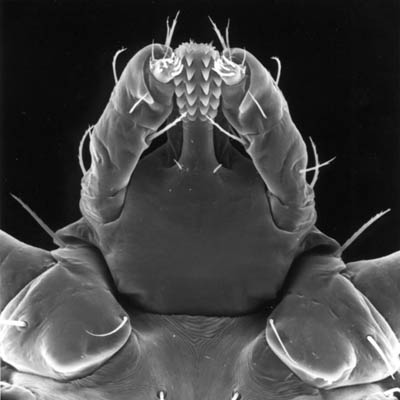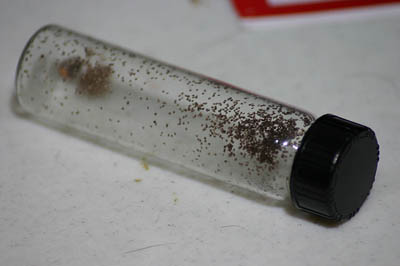 Dermacentor variabilis, female Credit: National Tick Collection |
Vicky and I went for a short hike in Chesapeake’s Northwest River Park last weekend, a lovely site filled with marshland and waterways for canoeing, camping, … and ticks. Hot summer days combined with the humidity of the wetlands climate equals lots and lots of ticks, and this hike was no exception.
Except for Vicky. While I had to stop every so many hundred yards to scan my legs for the little bloodsuckers, of which I was literally finding dozens, Vicky found maybe four on her the whole trip. What gives?
Carl Sagan gives a brief description of the life of a tick in his book Shadows of Forgotten Ancestors, and the small set of instinctual rules that command its life. Lacking eyes, ticks must find each other to mate by detecting the pheromones C6H3 OHCl2. Then:
After mating, the female climbs up a bush or shrub and out onto a twig or leaf. How does she know which way is up? Her skin can sense the direction from which light is coming, even if she cannot generate an optical image of her surroundings. Poised out on the leaf or twig, exposed to the elements, she waits. Conception has not yet occurred. The sperm cells within her are neatly encapsulated; they’ve been put in long-term storage. She may wait for months or even years without eating. She is very patient.
Makes the tick sound like a tiny clockwork machine, doesn’t it? It’s possible to have some fun with this instinctual behavior too. As when Vicky and I put a blood-engorged tick in a sealed vial, where it soon laid a bazillion eggs, which hatched a few months later.
 Baby Ticks Credit: Vicky |
The baby ticks all climbed to the top of the vial. When the vial was turned over, they all climbed to the highest point again. Over and over again, until they eventually stopped moving (Don’t tell PETA). It was like some twisted version of an hourglass, appropriate for some Tim Burton film. Try this sometime, it makes a great conversational piece when you have guests over that you’re not very fond of.
Eventually, the right stimulus comes along the forest path, triggering the tick to drop, hopefully (for her), onto something full of blood:
What she’s waiting for is a smell, a whiff of another specific molecule, perhaps butyric acid, which can be written C2H7COOH. Many mammals, including humans, give off butyric acid from their skin and sexual parts. A small cloud of the stuff follows them around like cheap perfume. It’s a sex attractant for mammals. But ticks use it to find food for prosepctive mothers.
Here’s the clue as to why I was getting bum-rushed with blood-sucking arachnids, while Vicky was passing through the forest virtually untouched, butyric acid. Vicky had showered that morning and put on fresh clothes, while I figured I’d shower after the hike, and put on my workout clothes from the day before. I even wore the same icky socks. Vicky was virtually clean of butyric acid, while I was fairly drenched in the stuff.
So while I like to joke that the ticks preferred me because I was sweeter, in reality, they wanted me because I was stinkier! (Why am I sharing this with you?)
In fact, this basic instinctual set of commands can cause the arachnid to exhibit some buggy (in a software-metaphor sense of the word) behavior, as with the stimulus to trigger her blood-drinking response:
It’s not the taste of the blood that attracts her, but the warmth. If she drops onto a butyric acid-scented toy balloon filled with warm water, she will readily puncture it and, an inept Dracula, gorge herself on tap water.
I think I have plans for some future fun with stinky socks and warm-water filled balloons in my future. : )
Comments
4 responses to “Fun With Tick Clockwork”